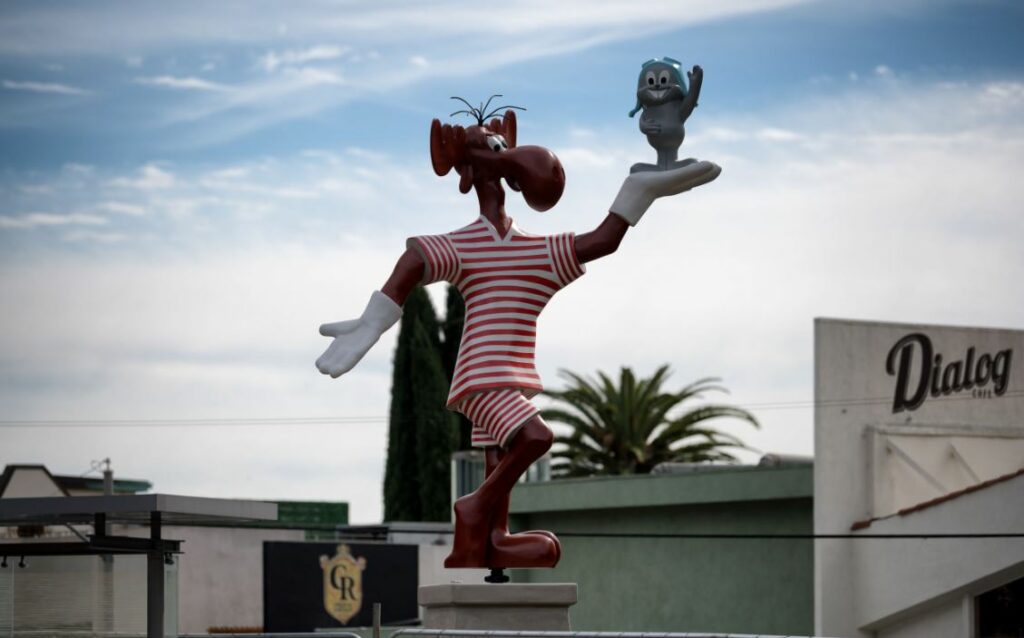West Hollywood, California is renowned for its myriad of iconic monuments that pay homage to the rich history and culture of the entertainment industry. Among these, one that stands out prominently is the statue of Rocky and Bullwinkle, a quintessential symbol representing an era when animation was in its nascent stage yet marked by profound creativity and innovation.
This eye-catching monument located on Sunset Boulevard serves as a vivid reminder of the enduring legacy left behind by Jay Ward, creator of the legendary animation duo – Rocket J. Squirrel (Rocky) and Bullwinkle J. Moose.
The existence of this statue not only commemorates the accomplishments within animation but also ignites nostalgia among those familiar with this celebrated animated series from yesteryears. The significance extends beyond mere representation; it encapsulates an important part of television history that has managed to transcend generations while simultaneously evoking feelings of warmth, familiarity, and communal belonging.
As such, exploring the story behind this revered monument provides an intriguing lens into understanding how elements from pop culture have been immortalized in physical form, thus creating shared cultural spaces where collective memories can be celebrated and relived.
The History of the Animation Duo
The animation duo, Rocky and Bullwinkle, first graced television screens in the late 1950s, marking the onset of a new era in cartoon history with their unique blend of wit, satire, and humor.
Created by Jay Ward and Alex Anderson, this duo emerged as an unconventional pair featuring Rocky J. Squirrel and Bullwinkle J. Moose. The dynamic between these characters was built on a set of contrasts: while Rocky represented intelligence and quick wit, Bullwinkle signified naivety yet good-heartedness.
The show quickly gained popularity due to its clever storytelling that combined both sophisticated humor for adults while maintaining appeal for younger viewers through its slapstick comedy.
The ‘Rocky and His Friends’ show initially aired during weekday afternoons until it earned prime-time status due to its skyrocketing popularity. The series demonstrated a level of depth rarely seen in animated programming at the time; it satirized politics, pop culture trends, societal norms while retaining engaging narratives filled with adventurous escapades of the duo themselves.
The creators infused an element of familiarity into each episode by drawing from well-known fairy tales or folktale adventures but adding their unique comedic spin to them—inviting audiences into a shared cultural experience through laughter and entertainment.
The Significance of the Sunset Boulevard Monument
Positioned strategically on Sunset Boulevard, this monument holds symbolic importance as it is a testament to the adage ‘a picture is worth a thousand words,’ representing an era of television history and pop culture in its own unique way.
The Rocky and Bullwinkle statue serves as a concrete embodiment of the 1960s animation boom, during which the characters gained immense popularity for their quirky humor and witty political satire. It further highlights the evolution of animated entertainment, from its rudimentary beginnings to its current status as a powerful storytelling medium. This tangible tribute showcases not only the artistic talent that went into creating such influential figures but also reflects societal values and trends of that time.
The monument’s strategic location on one of Hollywood’s busiest streets emphasizes its role as a cultural landmark. The vibrancy embodied by this iconic duo reverberates across generations, fostering nostalgia among older viewers while capturing the curiosity of younger ones who might be unfamiliar with these characters’ origins. Herein lies an unspoken invitation for all passersby to discover or rediscover Rocky and Bullwinkle’s impact on American television landscape — effectively uniting diverse audiences through shared appreciation for cultural heritage.
In this sense, the statue transcends beyond mere decoration; it becomes a symbol of collective memory, reminding us all that despite changes over time, some things remain timeless classics worthy of celebration.


